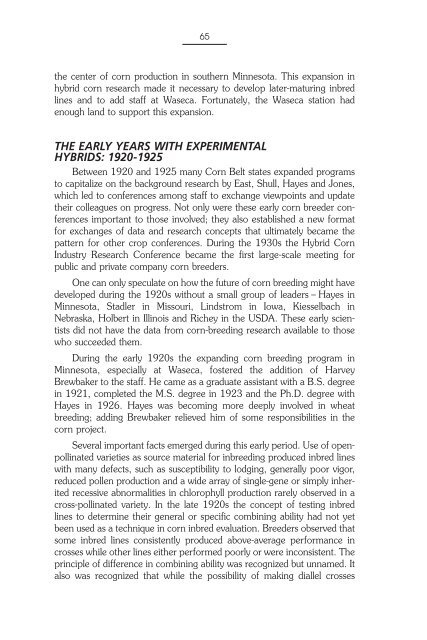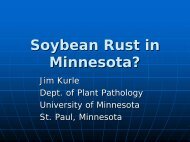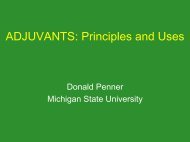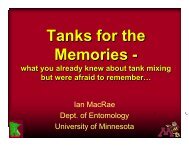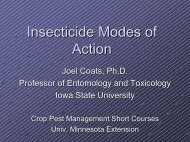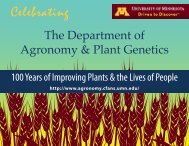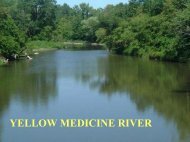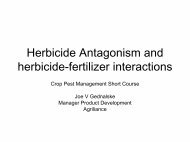- Page 2 and 3:
Agronomy and Plant Genetics at the
- Page 4 and 5:
Chapter 6 Foreword As a member of t
- Page 6 and 7:
Chapter 9 Preface On April 3, 1946,
- Page 8 and 9:
Chapter 9 Acknowledgments Compiling
- Page 10 and 11:
Chapter 9 Dedication Agronomy and P
- Page 12 and 13:
Contents Foreword .................
- Page 14 and 15:
Chapter 1 Milestones Milestones Loo
- Page 16 and 17:
3 1892 Coates P. Bull joins the fac
- Page 18 and 19:
5 1929 E.R. Ausemus stationed in th
- Page 20 and 21:
7 1993 David Somers appointed to en
- Page 22 and 23:
Chapter 2 Origin and Faculty The Mo
- Page 24 and 25:
11 vice chairman of the experiment
- Page 26 and 27:
13 The experiment station annual re
- Page 28 and 29: 15 HERBERT KENDALL HAYES H.K. Hayes
- Page 30 and 31: 17 five children and the second son
- Page 32 and 33: 19 During the 1960s he managed the
- Page 34 and 35: 21 coordinator of the USAID/Univers
- Page 36 and 37: 23 Tenure Faculty Member From To Sp
- Page 38 and 39: 25 Tenure Faculty Member From To Sp
- Page 40 and 41: Chapter 3 Department Buildings Farm
- Page 42 and 43: 29 Department Buildings Locator Map
- Page 44 and 45: Chapter 4 Recollections In the late
- Page 46 and 47: 33 Mrs. Margaret Taarud was born in
- Page 48 and 49: Chapter 5 Undergraduate Teaching Th
- Page 50 and 51: 37 CIRCA 1949 Much of the earlier i
- Page 52 and 53: 39 field plot design (applied stati
- Page 54 and 55: 41 Science in Agriculture (SCAG), p
- Page 56 and 57: 43 CIRCA 1999 This era brought anot
- Page 58 and 59: 45 and to identify and provide scie
- Page 60 and 61: Chapter 6 Extension Education The H
- Page 62 and 63: 49 Harley J. Otto was appointed ext
- Page 64 and 65: Chapter 7 Alfalfa Breeding and Path
- Page 66 and 67: 53 In 1948, clones and strains were
- Page 68 and 69: 55 resistant germplasms that became
- Page 70 and 71: 57 fee test program, guided by Duan
- Page 72 and 73: Chapter 8 Barley Improvement Barley
- Page 74 and 75: 61 COOPERATION WITH INDUSTRY A high
- Page 76 and 77: Chapter 9 Corn Improvement It is no
- Page 80 and 81: 67 of routine corn-breeding respons
- Page 82 and 83: 69 SWEET CORN AND POPCORN BREEDING
- Page 84 and 85: 71 it would be difficult to select
- Page 86 and 87: 73 CORN RESEARCH FROM 1940 The earl
- Page 88 and 89: 75 superior inbreds and single-cros
- Page 90 and 91: 77 over a wide range of environment
- Page 92 and 93: Chapter 10 Flax Improvement Flax wa
- Page 94 and 95: 81 development of varieties resista
- Page 96 and 97: Chapter 11 Forage Management Qualit
- Page 98 and 99: 85 Arny continued traditional crop
- Page 100 and 101: 87 itator) at Rosemount who was ver
- Page 102 and 103: 89 N from effluent and it was the m
- Page 104 and 105: 91 6 Marten and Jordan showed that
- Page 106 and 107: 93 Sheaffer led efforts in promotin
- Page 108 and 109: Chapter 12 Forage and Turf Seed Pro
- Page 110 and 111: 97 IRON RANGE RESOURCES FUNDING COM
- Page 112 and 113: Chapter 13 Forage Breeding and Gene
- Page 114 and 115: 101 grass. This technique of induci
- Page 116 and 117: Chapter 14 Genetics, Genetics, Cyto
- Page 118 and 119: 105 to the Royal Society of Canada,
- Page 120 and 121: 107 called ribosomal RNA genes. Thi
- Page 122 and 123: 109 somes in about one-third of the
- Page 124 and 125: Chapter 15 Oat Improvement Oat acre
- Page 126 and 127: 113 A paragraph in the 1920 MAES an
- Page 128 and 129:
115 transmitted by aphids. While bl
- Page 130 and 131:
117 ed backgrounds to improve the p
- Page 132 and 133:
119 Following Moore’s retirement
- Page 134 and 135:
121 OAT ACREAGE AND PRODUCTION STAT
- Page 136 and 137:
Chapter 16 Soybean Improvement The
- Page 138 and 139:
125 J.W. Lambert and J.H. Orf in so
- Page 140 and 141:
127 Variety Method of Development Y
- Page 142 and 143:
Chapter 17 Weed Science Coates P. B
- Page 144 and 145:
131 and occasionally others such as
- Page 146 and 147:
133 effect," to which corn is often
- Page 148 and 149:
135 ki and other crops has been bas
- Page 150 and 151:
137 jointly by the University of Mi
- Page 152 and 153:
Chapter 18 Wheat Improvement Effort
- Page 154 and 155:
141 Preparation for seeding wheat r
- Page 156 and 157:
143 crossed with Hope and then the
- Page 158 and 159:
145 33% of its acreage. During its
- Page 160 and 161:
Chapter 19 Wild Rice Breeding And P
- Page 162 and 163:
149 Wild rice research paddies at N
- Page 164 and 165:
151 he also studied day length and
- Page 166 and 167:
Chapter 20 New and Uncommon Crops R
- Page 168 and 169:
155 R.G. Robinson explains sunflowe
- Page 170 and 171:
Chapter 21 Branch Agricultural Expe
- Page 172 and 173:
159 University provided overall pla
- Page 174 and 175:
161 Field day at West Central Exper
- Page 176 and 177:
163 prise. The north 40 was to be t
- Page 178 and 179:
165 legislature appropriated $80,00
- Page 180 and 181:
167 (nothing added other than seed
- Page 182 and 183:
169 CROP AND ACREAGE ASSIGNED FOR I
- Page 184 and 185:
171 $.75, barley $1.50, flax $3, so
- Page 186 and 187:
173 Agronomists Period Otto I. Berg
- Page 188 and 189:
Chapter 22 Minnesota Crop Improveme
- Page 190 and 191:
177 meeting, in St. Cloud. The Univ
- Page 192 and 193:
179 ACRES CERTIFIED OF SELECTED CRO
- Page 194 and 195:
181 Secretary Period Willet M. Hays
- Page 196 and 197:
Chapter 23 Centers and Institutes T
- Page 198 and 199:
185 The Department of Agronomy and
- Page 200 and 201:
Appendix A Awards and Recognition O
- Page 202 and 203:
189 Robert E. Wagner Award for Effi
- Page 204 and 205:
191 RECIPIENTS OF CIVIL SERVICE EXC
- Page 206 and 207:
Appendix B Master of Science Gradua
- Page 208 and 209:
195 Block, Lawrence G. 1984 R.L. Ph
- Page 210 and 211:
197 Crookston, R. Kent 1970 D. Moss
- Page 212 and 213:
199 Garber, Edward D. 1942 C.R. Bur
- Page 214 and 215:
201 Jennings, Merlin R. 1957 A.R. S
- Page 216 and 217:
203 Marum, Petter 1977 A. Hovin Mat
- Page 218 and 219:
205 Omar, Abdel Aziz M. 1954 E.R. A
- Page 220 and 221:
207 Rogler, George A. 1942 H.K. Hay
- Page 222 and 223:
209 Tewari, Gayatri Prasad 1954 A.R
- Page 224 and 225:
211 Young, William I. 1966 D.C. Ras
- Page 226 and 227:
Appendix C Doctor of Philosophy Gra
- Page 228 and 229:
215 Brookins, Wallace W. 1940 F.R.
- Page 230 and 231:
217 Den Hartog, Gerald T. 1950 J.W.
- Page 232 and 233:
219 Guldan, Steven J. 1986 W.A. Bru
- Page 234 and 235:
221 Jones, Guy L. 1952 E.R. Ausemus
- Page 236 and 237:
223 McElroy, Jeffrey L 1998 D.C. Ra
- Page 238 and 239:
225 Pathak, Chandravadan H. 1952 R.
- Page 240 and 241:
227 Salhuana, Wilfredo S. 1969 R.E.
- Page 242 and 243:
229 Trimble, Michael W. 1985 D.K. B
- Page 244 and 245:
Appendix D Doctor of Philosophy Gra
- Page 246 and 247:
233 1982 CARTER, PAUL RUSSELL Thesi
- Page 248 and 249:
235 1995 SCHWAB, PHILIP M. Thesis:
- Page 250 and 251:
237 1957 MCKENZIE, RONALD IAN HECTO
- Page 252 and 253:
239 1979 BARHAM, ROBERT WARREN Thes
- Page 254 and 255:
241 1930 McINDOE, KENNETH GILLIES T
- Page 256 and 257:
243 1955 AGBLE, WILLIAM KWESI Thesi
- Page 258 and 259:
245 1978 GEBAUER, JUAN ENRIQUE Thes
- Page 260 and 261:
247 1995 ETA NDU, JACOB TIKU Thesis
- Page 262 and 263:
249 1943 SCHMID, ALOIS RUDOLPH Thes
- Page 264 and 265:
251 1984 HESTERMAN, ORAN BRYCE Thes
- Page 266 and 267:
253 1956 CLARK, EDWARD MAURICE Thes
- Page 268 and 269:
255 1969 BLACK, DONALD STEPHEN Thes
- Page 270 and 271:
257 1988 BENNER, MICHAEL SCOTT Thes
- Page 272 and 273:
259 1996 PAWLOWSKI, WOJCIECH Thesis
- Page 274 and 275:
261 1973 GRANGER, ROBERT MACK Thesi
- Page 276 and 277:
263 1970 RABAS, DAVID LEE Thesis: T
- Page 278 and 279:
265 1982 GROAT, RANDALL GENE Thesis
- Page 280 and 281:
267 1991 TWARY, SCOTT NICHOLAS Thes
- Page 282 and 283:
269 1967 AYLESWORTH, JOHN WILDE The
- Page 284 and 285:
271 1995 PAZDERNIK, DAVID LEONARD T
- Page 286 and 287:
273 1959 BURNSIDE, ORVIN CHARLES Th
- Page 288 and 289:
275 1980 WESTRA, PHILIP Thesis: Con
- Page 290 and 291:
277 1993 EVENSON, KIMBERLY JANE The
- Page 292 and 293:
279 1945 ATKINS, IRVIN MILBURN Thes
- Page 294 and 295:
281 1956 ASLAM, CHAUDHARI MUHAMMAD
- Page 296 and 297:
283 1992 KAMANZI, ABDUL Thesis: Cha
- Page 298 and 299:
285 BLUEGRASS l946 KRAMER, HERBERT
- Page 300 and 301:
287 ORCHARDGRASS 1940 SCHULTZ, HERM
- Page 302 and 303:
289 1994 ABADIE, TABARE Thesis: A C
- Page 304 and 305:
Appendix E Field Crop Varieties VAR
- Page 306 and 307:
293 Crop Cultivar Name Date Kasota
- Page 308 and 309:
295 Appendix F Index A A tribute to
- Page 310 and 311:
297 Crop improvement 171, 179 Quali
- Page 312 and 313:
299 Hayes, H.K. 4, 5, 8, 14, 15, 17
- Page 314 and 315:
301 Murphy, Royse 25, 103, 189, 190
- Page 316 and 317:
303 Seguin, P. 93 Selvig, Conrad 16
- Page 318 and 319:
305
- Page 320 and 321:
307
- Page 322 and 323:
309
- Page 324 and 325:
311


